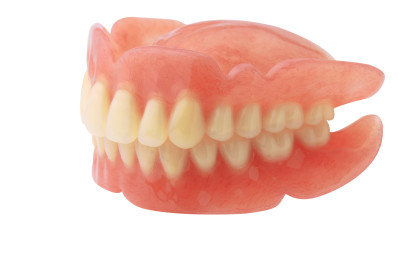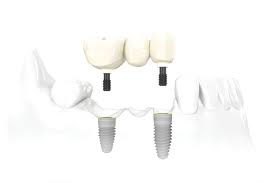Tooth replacement
Teeth may be lost at any stage in life due to disease such as caries (decay), periodontal disease (gum disease) or trauma. Some teeth never actually grow in some people (hypodontia) or are impacted in the jawbone and cannot erupt in the mouth.
Do I need to replace my missing teeth?
You do not need to replace every missing tooth. The need will depend on the impact on your appearance and function. Reasons for replacing a missing tooth (or teeth) vary and should be weighed against the risks of leaving the space, as well as resultant changes that may take place in the rest of your dentition. If you have teeth missing, it can affect the way the rest of your teeth bite together. Your remaining teeth may tilt and drift into the gaps and food can get trapped in the spaces. This can increase your risk of tooth decay and gum disease. If lots of your teeth are missing, your facial muscles can become saggy, and this can affect your speech and appearance.
Bone Loss
When teeth are removed from the jaw, the bone that supports the teeth tends to shrink over time. This process is called resorption and is a natural consequence of the loss of stimulation to the bone from the forces placed on the teeth. Resorption of the alveolar bone (bone that supports the teeth) begins almost as soon as the tooth is removed and proceeds over time. The bone will lose both height and width from resorption.
When multiple teeth are lost, with or without a prosthesis to replace them, significant loss of jaw bone can take place. This sometimes leads to difficulty wearing a removable denture due to lack of an adequate “ridge” upon which the denture can obtain stability. In the so-called “aesthetic zone” of the mouth, where loss of ridge volume can be visibly apparent to the naked eye, this can lead to an aesthetic defect due to the lack of support for the upper lip. As the bone resorbs, the gum which covers it also shrinks away, creating a concavity (depression in height and width) that can be unsightly as well as possibly promote food impaction under adjacent teeth. Implant prostheses can replace all tissues lost, both teeth and gums.

Drifting
Loss of one or two teeth in a segment of your mouth can lead to drifting of neighbouring teeth, whereby the adjacent teeth lean over into the vacant space where the teeth have been lost. Similarly, loss of a tooth or teeth can lead to shifting of opposing teeth as they drift down into the open space (super-erupt).
In general, our teeth have a constant tendency to move both towards the front of our mouths and towards the opposing jaw, unless they are stopped by something in their way, usually the adjacent or opposing teeth. Loss of teeth allows this to proceed in a pathologic way. As teeth drift, they create discrepancies in the height and contours of the gum tissue that predispose adjacent teeth to periodontal disease progression and/or dental decay due to the accumulation of food and plaque as well as the difficulty in cleaning these areas. Drifting teeth can also adversely affect the occlusion (bite), as well as the aesthetics of your face and smile.
How do I replace missing teeth?
Treatment options include the following: Removable Dentures (removable plastic or metal frameworks that carry false teeth), Bridges (false teeth that are fixed onto adjacent natural teeth), and Dental implants (titanium ‘screws’ are placed in your jawbone, and dentures, crowns or bridges are clipped or screwed on top of them). Replacement teeth are made to match the colour of your natural teeth as closely as possible. The most appropriate treatment for you will depend on the number of teeth you have missing. It will also depend on where teeth are missing in your mouth and the condition of any remaining teeth.
Removable partial dentures
A removable partial denture can replace one or more missing teeth. A partial denture is a framework (plate) with a number of false teeth on it. Removable partial dentures often have metal clasps to keep them in place, which might be visible or hidden. They must be removed and cleaned frequently in order to maintain oral hygiene as they can act as a food trap due to the extra bulk. More information may be found in the Removable Dentures section.
Removable full dentures
You will need removable full (or complete) dentures if you have no teeth left in your upper or lower jaw. They are usually made of a plastic plate with plastic or porcelain teeth. Full upper dentures cover the roof of your mouth (palate). A very thin layer of saliva between your palate and the denture creates suction, which keeps them firmly in position. Your facial muscles and tongue also help to keep them in place. Full lower dentures are often more difficult to keep in place because there is less support from your gums. It can be difficult to balance the denture against your cheeks and tongue. However, this should improve with time as you get used to it.
It’s very important to have realistic expectations of removable complete dentures. Getting used to them will take time and the length will depend on your adaptive capacity and neuromuscular control. Removable dentures will help you to eat, speak and smile confidently, but even the best dentures won’t feel the same as natural teeth. However, they may provide excellent aesthetic results. More information may be found in the Removable Dentures section.
Conventional tooth bridges 
If only one or two of your teeth are missing, a bridge may be a replacement alternative. This consists of two crowns, which are placed on your natural teeth either side of the space, with a false tooth in the middle. In order to construct a conventional tooth bridge the natural teeth on either side of the space may have to be reduced in their size (or cut down) to remove all the enamel, making room for the crowns to fit on top, although there are many designs that may be more conservative to your teeth. These crowns are permanently attached to a false tooth in the centre and they cannot be removed. Bridges are made of porcelain and/or metal.
The limitation of this form of treatment has to do with the irreversible preparation of the adjacent (abutment) teeth for support. The more invasive reductions may expose them to the risk of trauma to their nerves, raising the risk of requiring root canal treatment. Long-term, fixed bridges between natural teeth have an average life expectancy of 10-15 years before requiring replacement. More information may be found in the Crowns and Bridges section.
Dental implants
Dental implants are a means of replacing missing teeth. A dental implant is a small screw-type anchor made of the metal titanium that is inserted into the jawbone under local aneasthesia. Titanium is a well-documented, biocompatible material which is used as an implant material in various parts of the human body, from dental implants to hip replacement prostheses. After a healing period of a few months the normal jawbone healing response results in a functional integration with the implant surface termed as “osseointegration”. An osseointegrated dental implant is used as a solid support for crowns, bridges or dentures which are secured to the top of the implant. The new teeth look and feel similar to your natural teeth. The main advantage of dental implants for tooth replacement is that no damage has to be done to any adjacent teeth and this tends to prolong their lifetime.
A single implant may be used to replace one missing tooth, or if a number of teeth are missing then multiple implants can be used. Even if all teeth in the mouth are missing, implants may still be used as an alternative to a conventional removable denture. In this case implants are used either to retain fixed bridgework, or to augment the retention of removable dentures by using special attachments that allow the denture to clip on the implants.
You may preview several cases of missing teeth being replaced by different means in the iSmile Gallery. You may arrange for a consultation appointment so we can plan your tooth replacement together.













